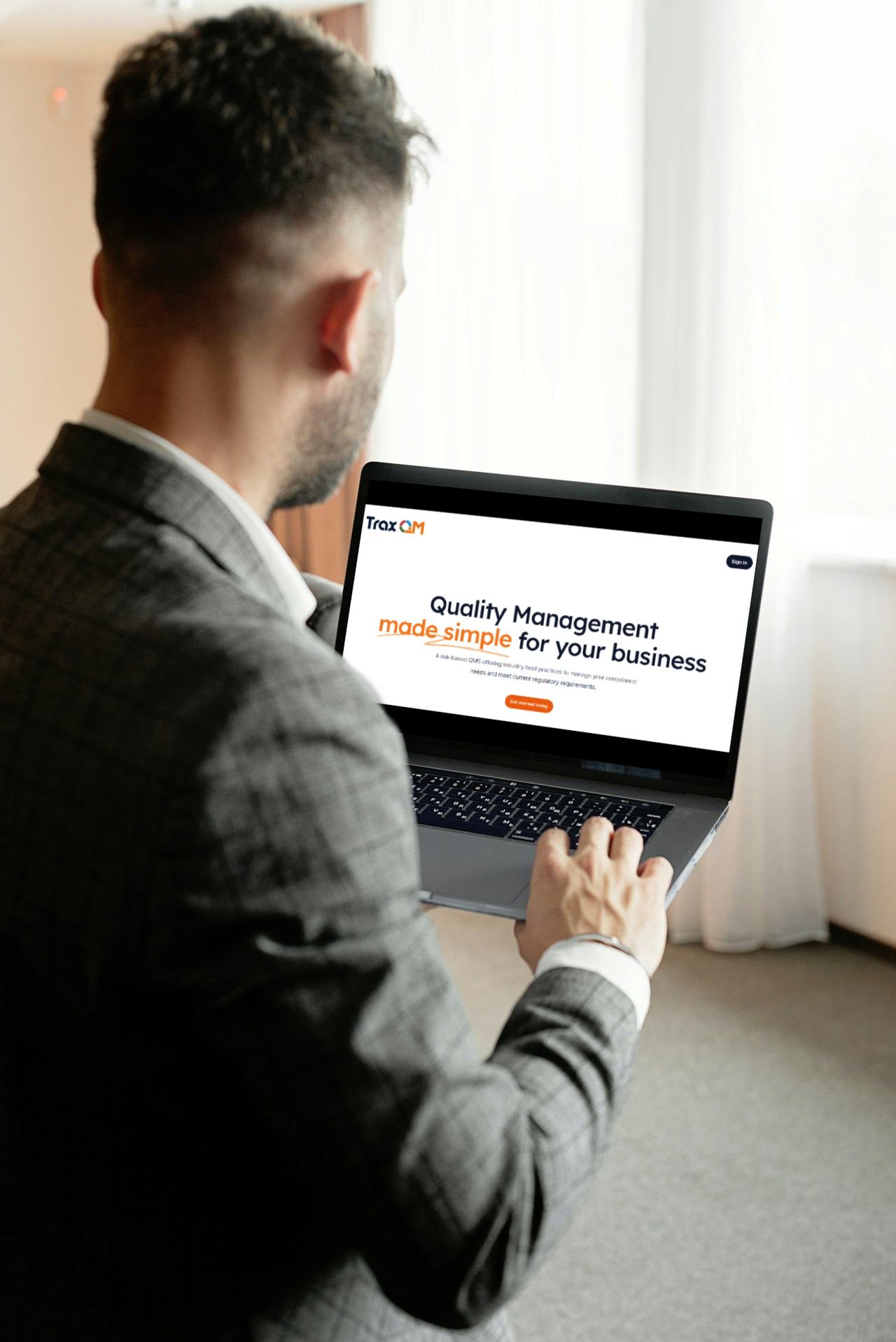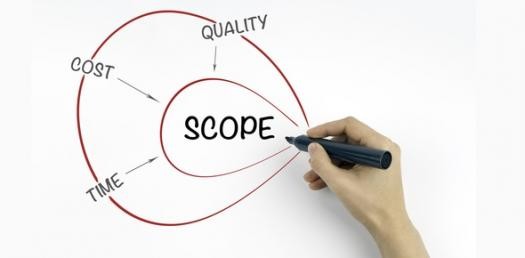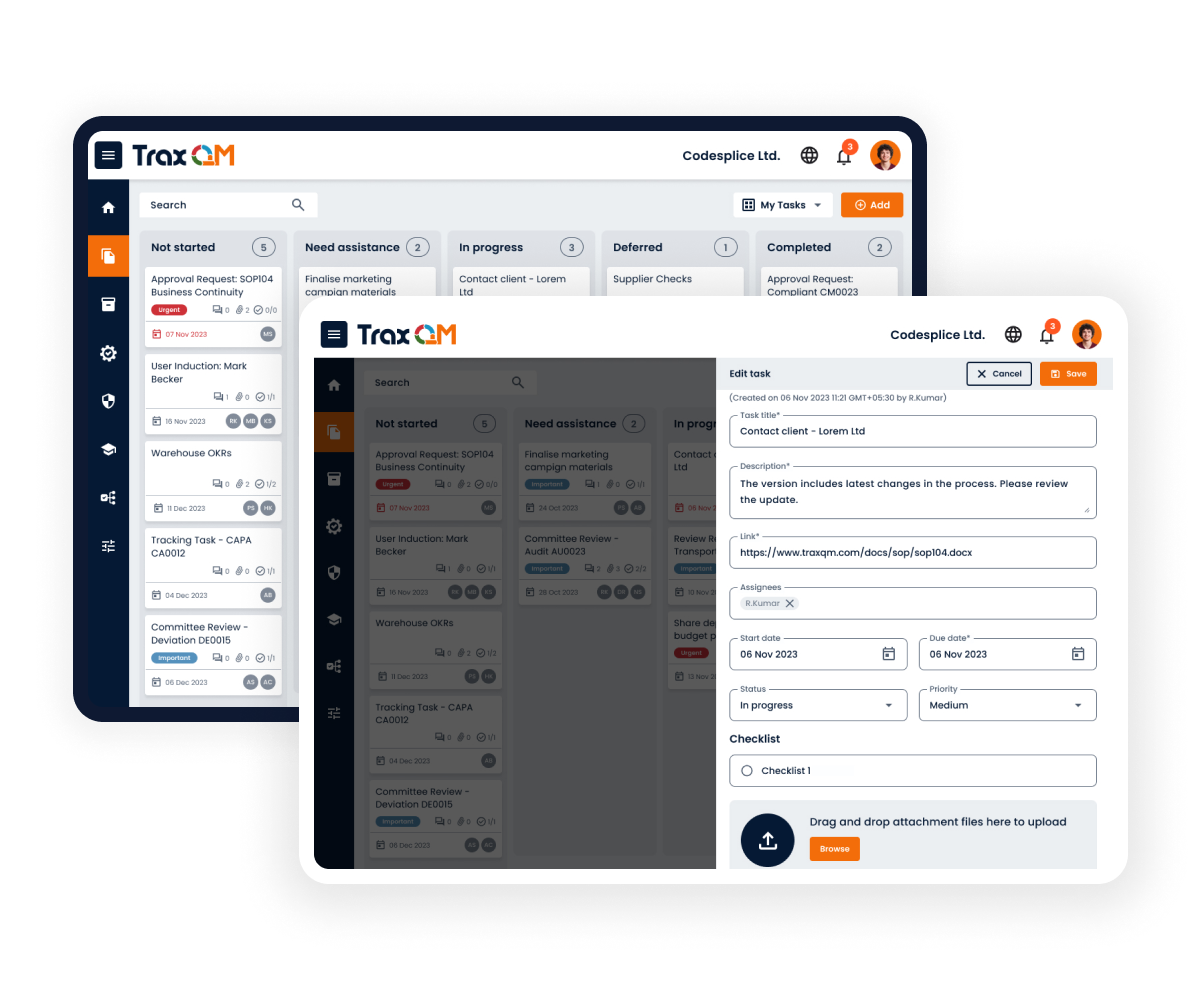
Role: UX Professional
Time: 10 months
Company: Codesplice
Type: SaaS Product
My part:
- Implemented ISO-compliant verification processes for CRM contacts, improving
data accuracy by 28%.
- Integrated AI-driven risk analysis to identify and mitigate potential
risks and KPIs proactively, significantly reducing errors of manual risk assessments.
- Developed audit and management setup enhancing risk-based internal audit
processes, track company objectives and contexts
- Crafted customizable dashboards and heatmaps to provide real-time insights
and effective system monitoring.
- Demonstrated Figma prototypes, eliciting constructive feedback to
refine designs.
TraxQM is a risk-based Quality
Management System (QMS) designed to drive operational excellence for
businesses. TraxQM comprehensive solution enhances critical quality processes,
covering CAPA, Complaint, Deviation, Change Control, and Risk Management.
What sets TraxQM apart is its user-friendly interface,
Kanban-based task management, and risk-based methodologies with support for
internal audits & management reviews.
AI-driven risk analysis for proactive quality control
Analyzes existing risks and suggests targeted control measures to mitigate potential issues
Enhance compliance, strengthen quality processes, and proactively address risks before they lead to non-conformance
Intelligent KPI recommendations
Suggests relevant Key Performance Indicators (KPIs) based on organisational objectives and risk profiles
Ensures a focused approach to monitoring, optimising resources and improving critical areas of business success
AI-powered document review for GxP compliance
Review documents and provide feedback on content quality and compliance with GxP guidelines
Ensures that documents meet regulatory standards, improving accuracy and adherence to industry best practices
Generate comprehensive training with AI
Quality content in just a few clicks? Check! Text, images, tests—cover every element of course creation and accelerate along the path to L&D success

A risk-based audit system which let users to record processes, take necessary actions and generate audit report based on compliance and non-compliance results.

Integrated AI to assess risks and KPIs to track the effectiveness of processes and controls to prevent risks.

A setup designed to record the Management Review meeting minutes and monitor the actions in the organisation.

Records the data of Assets and Contacts of the Organisation and provides a way to verify the data based on external database.
User research, Competitive analysis and Insights
01

Conducted
in-depth interviews with pharmaceutical auditors, compliance officers, and
QA professionals to understand their audit processes, pain
points, and requirements.
02

Conducted
a comprehensive analysis of regulatory requirements governing audit
management in the pharmaceutical industry, including FDA regulations, EMA
guidelines, and international standards (e.g., ISO 19011).
03

Evaluated
existing audit, risk and management solutions in the market, focusing on features,
user experience, compliance capabilities, and integration with QMS
platforms with SWOT.

Users spend significant time manually analyzing data to identify risks and recommend mitigation measures.

It is challenging for users to track KPIs based on different risks and intended results.

Users find it difficult to visualise and integrate necessary data in the management setup.
Define goals and brainstorm ideas
Based on our research
insights, I defined clear user personas, each representing a distinct user
archetype with unique needs and requirements.

Generate creative solutions to address the identified user needs and pain points.

What data AI should analyze in order to provide outcome?

What exactly the outcome should be?

CRM should integrate database and provides verification of the customers and suppliers in the organisation.

Auto generated report should be presented in audit and management review.
Example: Stages of audit like Identification, Evaluation, Action plan, Implementation and Review should be recorded.

Integrate data from different modules of QMS in management setup for an effective tracking of actions and processes.

Real-time data of QMS should be presented like risks, KPIs, events, controls, audits to visualise and track activites.
Low fidelity and High fidelity prototypes
Incorporated branding elements, colors, typography, and imagery to create a visually appealing and responsive design.
I implemented functional elements such as navigation menus, data input forms, search functionalities, and task flows to simulate real-world interactions.


Designed a powerful data visualisation tools that offer a comprehensive overview of the organisation's quality health.
Data:
Events- Complaints, Deviation, CAPA
Change controls
Tasks- According to status
Risks- Statistics and Heatmaps based on RPN
Designed to empower organisation with a robust, risk-based approach to managing internal and external audits.
Implemented audit processes with comprehensive features designed to ensure thorough compliance and continuous improvement.
Built robust set of tools to help organisations manage their structures, assets, and strategic plans effectively.
Tailored to meet real-world scenarios, our module ensures compliance and enhances operational efficiency.
Created Forms setup where users can design and implement custom forms to streamline quality processes, ensuring compliance with the GxP regulations.
It helps to digitise internal processes and enhance traceability with built-in validation and approval workflows.
Testing, Iteration and Launch
Conducted comprehensive testing for responsiveness using BrowserStack, a cloud-based testing platform that allows for testing across a wide range of browsers and devices.
Conducted usability
testing sessions with users on-site and virtually to gather feedback on the prototypes
and validate design decisions.
These sessions helped identify usability issues,
uncover user preferences, and refine the user interface based on real-world
usage scenarios.
Presented the Audit module, focusing on the key features, functionalities, and workflows infront of team and stakeholders.
Provided context on the goals and objectives of the Management module, emphasizing how the design aligns with user needs and business requirements.
Based on the feedback received from usability testing and stakeholder reviews, I iteratively refined the design which allowed me to address user concerns, incorporate new insights, and continually enhance the user experience.
The whole process involved extensive research, competitive analysis, design thinking, and iterative prototyping.
By incorporating user-centered design principles and industry-specific insights, the resulting system provides pharmaceutical companies with a powerful tool to streamline operations, ensure compliance, and drive business growth.
